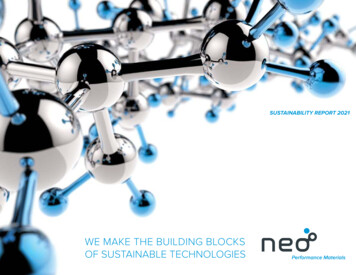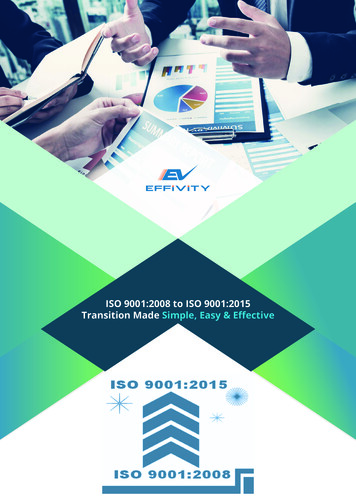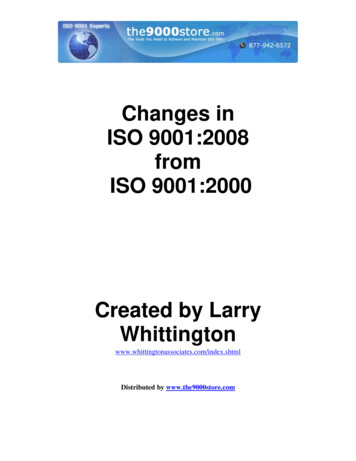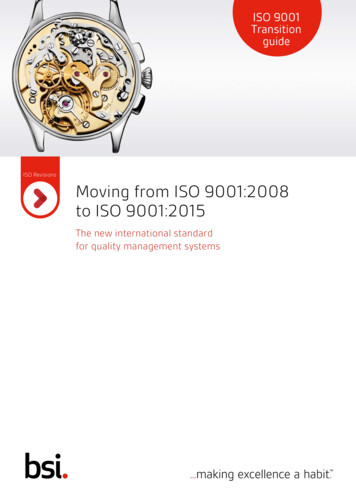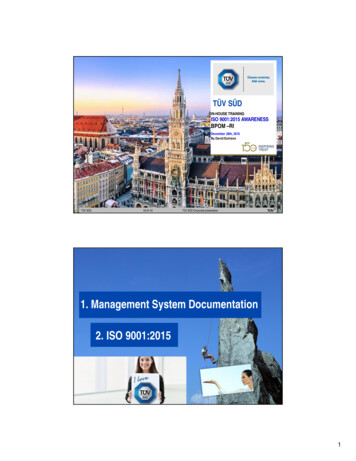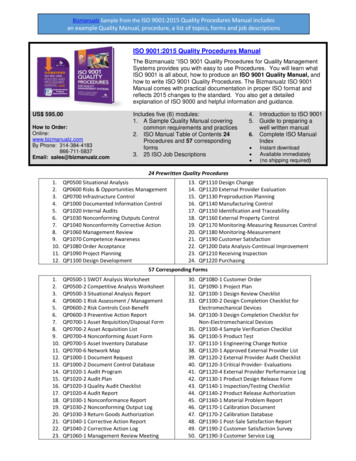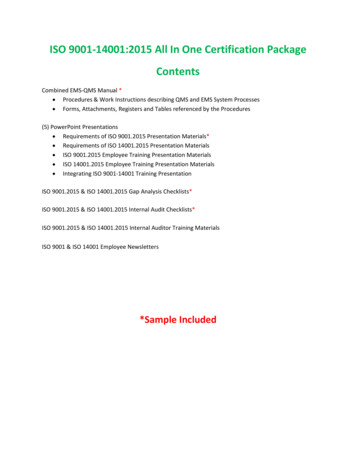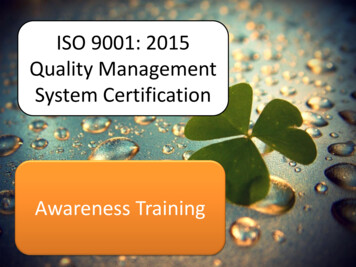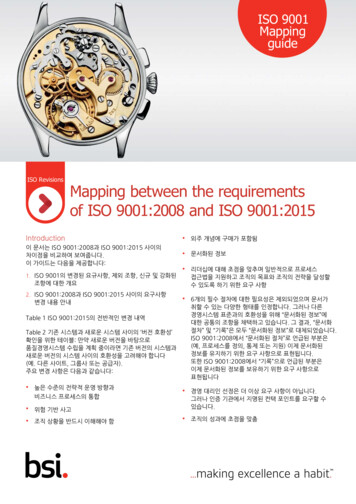
Transcription
ISO 9001MappingguideISO RevisionsMapping between the requirementsof ISO 9001:2008 and ISO 9001:2015Introduction 외주 개념에 구매가 포함됨이 문서는 ISO 9001:2008과 ISO 9001:2015 사이의차이점을 비교하여 보여줍니다.이 가이드는 다음을 제공합니다: 문서화된 정보1. ISO 9001의 변경된 요규사항, 제외 조항, 신규 및 강화된조항에 대한 개요2. ISO 9001:2008과 ISO 9001:2015 사이의 요구사항변경 내용 안내Table 1 ISO 9001:2015의 전반적인 변경 내역Table 2 기존 시스템과 새로운 시스템 사이의 ‘버전 호환성’확인을 위한 테이블: 만약 새로운 버전을 바탕으로품질경영시스템 수립을 계획 중이라면 기존 버전의 시스템과새로운 버전의 시스템 사이의 호환성을 고려해야 합니다(예. 다른 사이트, 그룹사 또는 공급자).주요 변경 사항은 다음과 같습니다: 높은 수준의 전략적 운영 방향과비즈니스 프로세스의 통합 위험 기반 사고 조직 상황을 반드시 이해해야 함 리더십에 대해 초점을 맞추며 일반적으로 프로세스접근법을 지원하고 조직의 목표와 조직의 전략을 달성할수 있도록 하기 위한 요구 사항 6개의 필수 절차에 대한 필요성은 제외되었으며 문서가취할 수 있는 다양한 형태를 인정합니다. 그러나 다른경영시스템 표준과의 호환성을 위해 “문서화된 정보”에대한 공통의 조항을 채택하고 있습니다. 그 결과, “문서화절차” 및 “기록”은 모두 “문서화된 정보”로 대체되었습니다.ISO 9001:2008에서 “문서화된 절차”로 언급된 부분은(예, 프로세스를 정의, 통제 또는 지원) 이제 문서화된정보를 유지하기 위한 요구 사항으로 표현됩니다.또한 ISO 9001:2008에서 “기록”으로 언급된 부분은이제 문서화된 정보를 보유하기 위한 요구 사항으로표현됩니다 경영 대리인 선정은 더 이상 요구 사항이 아닙니다.그러나 인증 기관에서 지명된 컨택 포인트를 요구할 수있습니다. 조직의 성과에 초점을 맞춤
ISO 9001 - Quality Management System - Mapping GuideISO Revisions1. Overview: 조항 번호 별 변경 사항ClauseRequirementClause 4‘이해관계자의 기대’ 와 ‘조직 상황’은 ‘고객 만족 달성’이라는 시스템의 목표에 영향을미치는 부분이므로, 이해관계자의 기대뿐만 아니라 조직의 내, 외부적 이슈에 대해 새로운요구 사항을 소개Clause 5리더십은 기존의 “경영 책임” 요구 사항의 대부분을 포함Clause 6Clause 7‘지원’은 기존의 6항 - 자원 관리 요구 사항의 대부분을 포함.그러나 ‘조직 지적 자원’ 관리에 대한 새로운 요구 사항이 포함 됨.Clause 8‘운영’은 기존의 7항 - 제품 실현을 대체하게 됨. 그러나 기존의 요구 사항 대부분을 포함.이 변경 사항의 의도는 서비스 분야에도 좀 더 적절하게 적용하기 위함임.Clause 9‘성과 평가’는 기존의 8항을 대체하며,이번에 6항 계획 부분에서 추가 언급한 예방 조치 내용을 조정.Clause 102시스템 범위에 영향을 미치는 위험 및 기회의 식별에 초점을 맞추는 ‘계획’ 부 분을 좀 더강조. 이는 2008 버전에 정의된 예방 조치의 필요성을 소거하는 역할을 하였으나, 변경관리 및 위험 관리에 대한 강화된 요구 사항을 필요로 함.‘개선’에 대해 좀 더 초점을 맞추고 기존 8항에 있던 부적합 및 시정 조치를 포함
ISO Revisions2. ISO 9001:2008 to ISO 9001:2015 Correlation MatrixISO 9001:2008ISO 9001:20154Quality management system4Context of the Organization4.1General requirements4.4Quality management system and its processes4.2Documentation requirements7.5Documented information4.2.1 General7.5.1General4.2.2 Quality manual4.3Determining the scope of the quality managementsystem7.5.1General4.4Quality management system and its processes4.2.3 Control of documents4.2.4 Control of records7.5.2Creating and updating7.5.3Control of documented information7.5.2Creating and updating7.5.3Control of documented information5Management responsibility5Leadership5.1Management commitment5.1Leadership and commitment5.1.1Leadership and commitment for the qualitymanagement system5.2Customer focus5.1.2Customer focus5.3Quality policy5.2Quality policy5.4Planning6Planning for the quality management system5.4.1 Quality objectives6.2Quality objectives and planning to achieve them5.4.2 Quality management system planning6Planning for the quality management system6.1Actions to address risks and opportunities6.3Planning of changes5.5Responsibility, authority and communication5.5.1 Responsibility and authority55.35.5.2 Management representativeLeadershipOrganizational roles, responsibilities and authoritiesTitle removed5.3Organizational roles, responsibilities and authorities5.5.3 Internal communication7.4Communication5.69.3Management review5.6.1 General9.3.1Management review5.6.2 Review input9.3.1Management review5.6.3 Review output9.3.2Management review6Resource management7.1Resources6.1Provision of resources6.2Management review7.1.1General7.1.2PeopleHuman resourcesTitle removed7.2CompetenceContinued 3
ISO 9001 - Quality Management System - Mapping guideISO Revisions2. Mapping table – continuedISO 9001:2008ISO 9001:20156.2.1 General7.2Competence6.2.2 Competence, training and e7.1.3Infrastructure6.4Work environment7.1.4Environment for the operation of processes7Product realization8Operation7.1Planning of product realization8.1Operational planning and control7.2Customer-related processes8.2Determination of requirements for products andservices7.2.1 Determination of requirements related to the product8.2.2Determination of requirements related to productsand services7.2.2 Review of requirements related to the product8.2.3Review of requirements related to products andservices7.2.3 Customer communication8.2.1Customer communication7.38.5Production and service provision8.3Design and development of products and services8.3.1General8.3.2Design and development planning7.3.2 Design and development inputs8.3.3Design and development inputs7.3.3 Design and development outputs8.3.5Design and development outputs7.3.4 Design and development review8.3.4Design and development controls7.3.5 Design and development verification8.3.4Design and development controls7.3.6 Design and development validation8.3.4Design and development controls7.3.7 Control of design and development changes8.3.6Design and development changes7.48.4Control of externally provided products and services8.4.1General8.4.2Type and extent of control of external provision7.4.2 Purchasing information8.4.3Information for external providers7.4.3 Verification of purchased product8.6Release of products and services7.58.5Production and service provisionDesign and development7.3.1 Design and development planningPurchasing7.4.1 Purchasing processProduction and service provision7.5.1 Control of production and service provision8.5.1Control of production and service provision8.5.5Post-delivery activities7.5.2 Validation of processes for production and serviceprovision8.5.1Control of production and service provision7.5.3 Identification and traceability8.5.2Identification and traceability7.5.4 Customer property8.5.3Property belonging to customers or external providers7.5.5 Preservation of product8.5.4PreservationContinued 4
ISO Revisions2. Mapping table – continuedISO 9001:2008ISO DIS 9001:20147.6Control of monitoring and measuring equipment7.1.5Monitoring and measuring resources8.0Measurement, analysis and improvement9.1Monitoring, measurement, analysis and evaluation8.1General9.1.1General8.2Monitoring and measurement9.1Monitoring, measurement, analysis and evaluation8.2.1 Customer satisfaction9.1.2Customer satisfaction8.2.2 Internal audit9.2Internal audit8.2.3 Monitoring and measurement of processes9.1.1General8.2.4 Monitoring and measurement of product8.6Release of products and services8.3Control of nonconforming product8.7Control of nonconforming process outputs, productsand services8.4Analysis of data9.1.3Analysis and .3Continual Improvement10.2Nonconformity and corrective action8.5.1 Continual improvement8.5.2 Corrective action8.5.3 Preventive actionClause removed6.1Actions to address risks and opportunities(see 6.1.1, 6.1.2)ReferencesISO/TC 176/SC 2 Documents N1224, July 2014ISO/TC 176/SC 2 Dated: 2014-05-8 ISO/DIS 9001The trademarks in this material (for example the BSI logoor the word “KITEMARK”) are registered and unregisteredtrademarks owned by The British Standards Institution inUK and certain other countries throughout the world.5
ISO 9001 - Quality Management System - Mapping guideISO Revisions3. ISO DIS 9001:2014 to ISO 9001:2008 Correlation MatrixISO DIS 9001:2014ISO 9001:20084Context of the organization1.0Scope4.1Understanding the organization and its context1.1General4.2Understanding the needs and expectations of interestedparties1.1General4.3Determining the scope of the quality management system1.2Application4.2.2Quality manual4.44Quality management system4.1General requirements5Leadership5Management responsibility5.1Leadership and commitment5.1Management commitment5.1.1Leadership and commitment for the quality managementsystem5.1Management commitment5.1.2Customer focus5.2Customer focus5.2Quality policy5.3Quality policy5.3Organizational roles, responsibilities and authoritiesQuality management system and its processes5.5.1Responsibility and authority5.5.2Management representative6Planning for the quality management system5.4.2Quality management system planning6.1Actions to address risks and opportunities5.4.2Quality management system planning8.5.3Preventive action6.2Quality objectives and planning to achieve them5.4.1Quality objectives6.3Planning of changes5.4.2Quality management system planning7Support6Resource management7.1Resources6Resource management7.1.1General6.1Provision of resources7.1.2People6.1Provision of Environment for the operation of processes6.4Work environment7.1.5Monitoring and measuring resources7.6Control of monitoring and measuring equipment7.1.6Organizational ce, training and awareness7.3Awareness6.2.2Competence, training and awareness7.4Communication5.5.3Internal communication7.5Documented information4.2Documentation requirements7.5.1General4.2.1GeneralContinued 6
ISO Revisions3. Mapping table – continuedISO DIS 9001:2014ISO 9001:20087.5.24.2.3Control of documents4.2.4Control of records7.5.34.2.3Control of documents4.2.4Control of records8Operation7Product realization8.1Operational planning and control7.1Planning of product realization8.2Determination of requirements for products and services7.2Customer-related processes8.2.1Customer communication7.2.3Customer communication8.2.2Determination of requirements related to products andservices7.2.1Determination of requirements related to the product8.2.3Review of requirements related to the products and services 7.2.28.3Design and development of products and services7.38.3.1GeneralNew8.3.2Design and development planning7.3.1Design and development planning8.3.3Design and development inputs7.3.2Design and development inputs8.3.4Design and development controls7.3.4Design and development review7.3.5Design and development verification7.3.6Design and development validation8.3.5Design and development outputs7.3.3Design and development outputs8.3.6Design and development changes7.3.7Control of design and development changes8.4Control of externally provided products and services7.4.1Purchasing process8.4.1General7.4.1Purchasing process8.4.2Type and extent of control of external provision7.4.1Purchasing process7.4.3Verification of purchased product8.4.3Information for external providers7.4.2Purchasing information8.5Production and service provision7.5Production and service provision8.5.1Control of production and service provision7.5.1Control of production and service provision8.5.2Identification and traceability7.5.3Identification and traceability8.5.3Property belonging to customers or external providers7.5.4Customer property8.5.4Preservation7.5.5Preservation of product8.5.5Post-delivery activities7.5.1Control of production and service provision8.5.6Control of changes7.3.7Control of design and development changes8.6Release of products and services8.2.4Monitoring and measurement of processes7.4.3Verification of purchased product8.78.3Control of nonconforming productCreating and updatingControl of documented InformationControl of nonconforming process outputs, productsand servicesReview of requirements related to the productDesign and developmentContinued 7
ISO 9001 - Quality Management System - Mapping guideISO RevisionsISO Revisions성공적인 전환을 위한 5 주요 단계미루지 마십시오 – 전환을 위한 작업을 오늘부터 시작하십시오14BSI 담당 심사원과 의논하십시오내부 프로젝트 팀을 구성하십시오 개정 과정을 도와줄 BSI 개정 도구를 다운로드 귀사의 도전 과제와 일정을 의논하십시오 추가 정보를 얻기 위해 BSI의 웹사이트를받으십시오 귀하의 현재 시스템에 대해 갭분석을 실시합니다방문하여 최신 설명 자료를 확인하십시오 실행 계획를 수립하고 진행 상황을 모니터링합니다2BSI 교육 과정에 참여하십시오 귀하의 QMS를 새로운 각도에서 바라보십시오 교육 과정에 참여하시어 새로운 요구 사항에 대해 리더십, 위험, 외부 조달 및 조직 환경에 대한더 빠르고 더 자세하게 이해할 수 있도록 합니다:소개 과정부터 새로운 영역을 설명하는 심화과정까지 다양새로운 조항을 실행합니다 새로운 구조를 반영하기 위한 문서화 작업을실행합니다3귀하의 조직과 커뮤니케이션 하십시오 5새로운 요구 사항에 대해 귀하의 경영진과의논하십시오갭분석/전환 심사 BSI는 실제 심사에 앞서 귀하의 취약점을 식별할 수있도록 갭분석을 진행할 수 있습니다 귀하의 조직과 개정에 대해 의논하여 이해를 FDIS에 대한 조기 심사를 고려해봅니다 새로운 표준에 대한 전환 심사는 개정판이 발행된얻도록 합니다 진행 상황에 대해 정기적으로 업데이트합니다직후부터 가능합니다ISO Revisions20152015년 7월FDIS 9001 발행2016201720182015년 9월2018년 9월까지 약 3년의 전환 기간 시작 BSI Group2015년 9월ISO 개정판 발행BSI/UK/550/SC/1214/en/BLDISO 9001:2015 Transition TimelineVisit our websiteto find out the latest statuswww.bsigroup.com/IS09001Revisionbsigroup.com
ISO/TC 176/SC 2 Documents N1224, July 2014 ISO/TC 176/SC 2 Dated: 2014-05-8 ISO/DIS 9001. 6 ISO 9001 - Quality Management System - Mapping guide 3. ISO DIS 9001:2014 to ISO 9001:2008 Correlation Matrix 4 Context of the organization 1.0 Scope 4.1 Understanding the organization and its context 1.1 General

